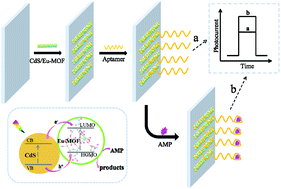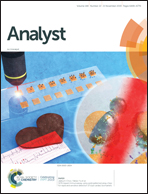Synthesis of a CdS-decorated Eu-MOF nanocomposite for the construction of a self-powered photoelectrochemical aptasensor
Abstract
A composite of CdS nanoparticles and a europium metal organic framework (Eu-MOF) (CdS/Eu-MOF) was synthesized. The unique properties of MOFs help to improve the photoelectrochemical (PEC) properties of CdS by reducing charge carrier recombination and utilizing a broader spectrum for light harvesting. Under visible light illumination, the photocurrent of the CdS/Eu-MOF composite modified electrode was about 2.5-fold higher than that of the CdS modified electrode. When an ampicillin (AMP)-binding aptamer was immobilized on the CdS/Eu-MOF modified electrode as a recognition element, a self-powered PEC aptasensor exhibiting a specific photocurrent response to AMP was constructed. Several experimental conditions such as the ratio of CdS to MOF, the coating amount of the CdS/Eu-MOF suspension and the concentration of the aptamer were studied. Under optimum conditions, the photocurrent of the developed sensor was linearly related to the logarithm AMP concentration in the range of 1 × 10−10 to 2 × 10−7 M, with a detection limit (3S/N) of 9.3 × 10−11 M. Moreover, this sensor exhibited excellent selectivity, good repeatability and desirable stability. It was successfully applied to the detection of AMP in lake water and milk samples.



 Please wait while we load your content...
Please wait while we load your content...